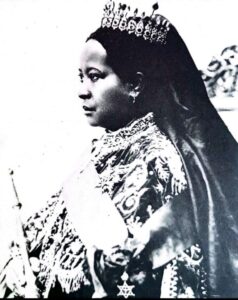ZAWDITU
- 4 Min Read
Zawditu (1876-April 1, 1930), empress of Ethiopia from 1916-30, was the natural child of Emperor Menilek II [reigned 1889-1913], and became the first reigning female monarch of Ethiopia.

PHOTO CAPTION: Zawditu. empress of Ethiopia (1876-April 1, 1930) SOURCE: EA Library
Born in 1876, she was raised as a princess, but with no idea that she might ascend the throne. Yet, as Menilek’s daughter, she participated in politics, and, in September 1882, she was married to the son and heir of Yohannes IV [reigned 1872-89], Ras Areaya Selassé, as part of a political settlement between Menilek, then king of Shawa, and Emperor I Yohannes.
The marriage could not be consummated, as she was six when it took place, and her husband died on June 10, 1888. She next married Dajazmach Gwangul Zegé, whose family had suffered from Menilek’s territorial re-arrangements in the Yaju-Wallo area. The marriage and political re-conciliation soon failed, because Menilek proved unwilling to restore lands which he had ceded to Dajazmach Walé of Yaju. After her divorce, Zawditu was therefore free to marry Dajazmach Webé Atenaf Sagad of Mietche, 30 mi (48 km) northwest of Addis Ababa, in January 1894.
Zawditu and Webé were divorced, however, probably because of the political ambitions of Taytu Betul, the wife of Menilek. Menilek had no direct male successor, and only two daughters by a previous marriage, one of whom was married to Ras Mikael, or Mohamed Ali, of Wallo. By this marriage, Menilek had a grandson, Lej Iyasu Mikael, who, as the only male descendant, seemed a likely heir.
Taytu was, however, well aware of the vagaries of Ethiopian politics, and could foresee the possibility of the throne going to one of Menilek’s daughters, tradition not-withstanding. Zawditu being the eldest, Taytu evidently urged the emperor to marry her to Dajazmach Gugsa Walé, her nephew, who was the son of Ras Walé of Yaju, her brother. Although Taytu’s scheme to obtain the throne for her family failed when Lej lyasu was selected as Menilek’s heir in April 1900, the marriage between Gugsa and Zawditu was successful.
During Menilek’s illness, Lej lyasu was proclaimed his heir in 1909, and became regent in 1911. In December 1913, after Menilek’s death, in order to prevent any potential political intrigues, Ras Tafari Makonnen, the governor of Harar, later to become Emperor Haile Selassie [reigned 1930-74] acted immediately to separate Gugsa from Zawditu. In 1916, Shawan politicians, who felt that Lej Iyasu’s pro-Islamic activities were destroying Menilek’s state, staged a coup, under the leadership of Ras Tafari, and unseated Lej lyasu.
On September 25, 1916, a triumvirate, consisting of Zawditu, who was proclaimed empress of Ethiopia, Ras Tafari, who became regent and heir, and Menilek’s devoted servant, Fitawrari Habta Giyorgis (1851-1926), the commander-in-chief of the army, who represented traditional political leadership, was formed. Zawditu’s coronation took place on February 11, 1917. Throughout Zawditu’s reign, Gugsa, her husband, repeatedly attempted to regain his position, but failed, because of the opposition of the two other men.
Within the triumvirate, Zawditu had control over internal administration. A deeply religious traditionalist, she suspected innovation because she associated change with an increase in Tafari’s power, and with alien religious forms. Habta Giyorgis was also a conservative who tended to link foreign ideas with European imperialism. Both individuals were naturally apprehensive of the consequences of Ras Tafari’s programs of modernisation. But the regent consolidated his position until, after the death of Habta Giyorgis in 1926, he became the dominant political figure in Ethiopia. Tafari’s coronation as Negus in October 1928, and the increase in his power, merely reflected the realities in Ethiopia.
During the last two years of her reign, therefore, Zawditu turned inward, and became a mystic. When her husband, Gugsa, died on March 31, 1930, in a battle with imperial forces, after he had attempted to depose Tafari, Zawditu appears to have had a nervous and physical breakdown. She died on April 1, 1930.
HAROLD G. MARCUS




